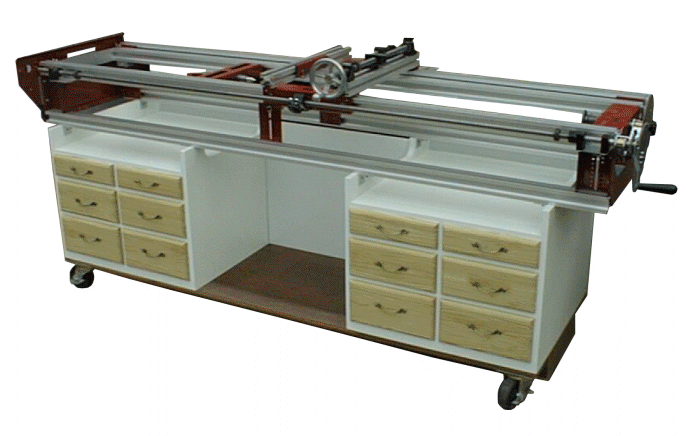|
|
|
 |
|
In order to make the Legacy Mill more useful in my shop I built a mobile cart to set it on. The picture above shows the Legacy mounted on the cart. There were several design considerations I wanted to take into account when I build the cart:
I had originally intended to apply some turnings
made on the mill to the cart itself but I've since put off that aspect, unless I get bored
some day. The cart consists of 4 modules bolted together:
The platform and bulkhead are basically torsion boxes, the drawer cabinets are simple Melamine boxes with dividers set in dado grooves. The mill is attached to the cabinets using eight 1.5" aluminum angle brackets which accept the bolts placed in the mill rails.
|
|
 |
|
This is a view of the cart before the drawers were installed. Very simple boxes with dividers make up the drawer bays. There are no runners used to guide the drawers, the dividers are sufficient for this. The drawers themselves are also very simple boxes made of plywood stapled together and have a flat bottom. The drawers were finished and coated with wax so that they would glide smoothly. On small drawers such as this metal glides are overkill but there were two main reasons why I did not use them. The first is that if used the drawers would tend to open when a big cart such as this is moved around. The second reason was cost, even cheap $6/pr glides would have added $72 to the cost of the cart. Many of the selections for materials were made to use what I had on hand at the time.
|
|
 |
|
Since nearly all flat surfaces tend to accumulate junk in my shop I planned ahead for this. I made several trays that can be laid onto the mill rails that provide a sacrificial surface for junk to accumulate. It is far easier to move / remove these trays when I want to use the mill than to remove individual items from the mill or cart itself.
|
|
|
This is a close-up view of one of the trays; nothing fancy, just a plywood bottom stapled to a pine frame. |